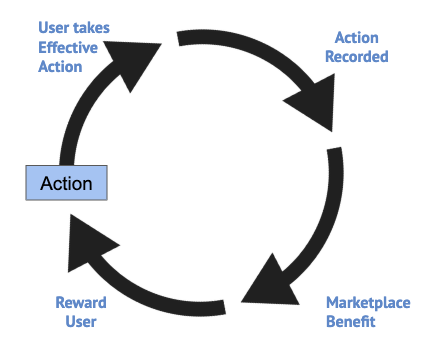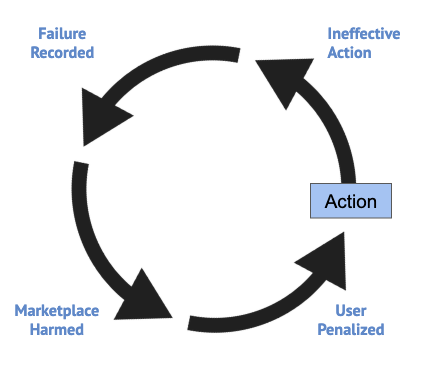Building Marketplace Incentive Loops
Note of Context: this is an edit of a paper I wrote for internal use at Zaarly, a startup building a marketplace for home services. Now that the company is sold, I’m sharing some of the work in hopes it will be helpful for others building marketplaces.
Marketplaces are Incentive Problems
In a marketplace, the “inventory” is sentient. It makes its own decisions about when it wants to be sold, when, to whom, and for how much. Imagine running a grocery store when Twinkies raise their own prices, Gatorade has gotten a different job, and Milk has lost its phone and not replied to anyone in 3 days. Challenging.
One challenge in a marketplace is aligning buyers and sellers. Both sides of the market come together to transact, and each is dependent on the behavior of the other for success.
The toolkit for creating those successful behaviors: Incentives.
“Never, ever think about something else when you should be thinking about the power of incentives.”
- Charlie Munger
The challenge of a marketplace (and the value created) is the ability to affect behavior in a way that drives commerce. Incentives encourage and reinforce admirable behavior.
Airbnb promotes listings when hosts have excellent photos, which benefits buyers.
eBay rewards sellers who offer free shipping, which improves buyer experience.
Uber offers bonuses for drivers who stay on the road longer, providing shorter wait times.
Amazon uses Prime subscriptions to subsidize free two-day shipping for buyers.
Designing Marketplace Incentives
Incentives Must be Scalable, Repeatable Loops
As an element of enormous marketplaces, incentives need to be scalable -- infinitely repeatable, in parallel. They need to be low-cost and low-friction. They need to affect the decisions and behavior of millions of people all over the world at the same time.
Successful marketplaces build software to reinforce incentives and disincentives over and over again, continually improving the quality of the marketplace, and outcomes for users.
Amazon offers credits for choosing buyers who accept slower, cheaper shipping options.
Lyft uses star ratings of riders and drivers to automatically moderate quality, favoring well-reviewed users and (eventually) banning poorly-reviewed users.
Airbnb rewards its best hosts with Superhost status, including badges and ranking boost.
Incentives Must Include Disincentives
Successful systems aren’t built entirely on positive reinforcement -- where there are incentives, there need to be disincentives. Rewards and penalties.
For each user-type action, there is an effective action, and… any number of ineffective actions (including non-action). To influence behavior toward the effective actions, ineffective and non-actions need to be observed, recorded, disincentivized, and communicated.
“People who create things like cash registers, which make immoral behavior hard, are some of the effective saints of our civilization.”
- Charlie Munger
Uber charges a $5 penalty to riders who cancel rides after 5 minutes, for wasting driver time.
Airbnb requires high response rates to ensure hosts are attentive to guests and penalize slower communicators with lower search rankings.
Instacart dismisses shoppers who decline too many incoming requests.
Incentives Must be Significant
Rewards and penalties need to be meaningful -- worth altering behavior for. To break habits or overcome moments of hesitation, the nudge toward effective behavior has to be strong enough to overcome the habit.
As habits of behavior play out over longer timelines, and rewards and penalties should slowly increase in significance. The tenth infraction should be penalized more severely than the first.
Incentives Must be Simple
The effective actions and rewards/penalties must be simple. Super simple. Clear to communicate. Easy to remember. Obvious to comply with.
We depend on these incentives to drive effective actions across millions of diverse people in various places, times, and pressures. Simple behaviors, simple rewards, simple penalties.
Uber wants riders to click the big button.
eBay wants sellers to ship quickly.
Airbnb wants hosts to accept all guests.
Incentives Must be Timely
To change behavior, our significant, simple rewards and penalties must be delivered quickly. A tight feedback loop between action and response ties response closely with action, making incentives more powerful.
Incentives Must be Consistent
In order to have any effectiveness at all, rewards and penalties need to be applied consistently and fairly across all users. Effective behaviors can’t be fakeable, and penalties can’t be dodgeable. There can be no selective enforcement, no exceptions, and no ‘moving the goalposts’ by the marketplace.
Exploitable systems will be exploited -- marketplaces need to carefully select their actions, behaviors, rewards, and penalties in order to create a cheat-proof system that will nudge users toward effective behaviors that benefit all users and the marketplace ecosystem itself.
“I think I’ve been in the top 5% of my age cohort all my life in understanding the power of incentives, and all my life I’ve underestimated it.”
- Charlie Munger
Communicate Clearly and Relentlessly
An incentive system is worthless until it is communicated. People always overestimate the clarity of our own communications, and underestimate the volume of communication necessary.
“When you think you’ve communicated something too much, you’re just beginning to get through. There is no such thing as too much communication.”
- Jonathan Rosenberg, SVP Product @ Google.
It will take dozens, maybe hundreds of impressions with different mediums, channels, and phrasing to begin to get through to someone. Always overinvest in communicating effective actions, incentives, and penalties. Expect change to take months or years.
Think about this reminder from Todd Lutwak, former VP of Seller Development at eBay and partner at Andreessen Horowitz:
Awareness ≠ Understanding
Understanding ≠ Acceptance
Acceptance ≠ Implementation
Communication is the first 70% of the progress here, and effective communication is a precursor for any kind of incentive to take hold. We rely on excellent communication to get us through Awareness, Understanding, and Acceptance. Incentives help us provide the final nudge into the Implementation of a behavior.
Use the product experience of the marketplace to communicate effective actions, and relevant rewards and penalties.
Airbnb communicates the penalty for declining too many guests in a modal as you decline.
eBay has a dashboard with key metrics with progress toward rewards or proximity to penalties.
Uber shows the total earnings of a shift add up, constantly reinforcing its value to drivers.
Now we combine our incentive loop and our disincentive loop to create one model of the full feedback loop of an action:
Make Effective Actions [Astoundingly] Easy
Determine effective actions by carefully studying behavior of your buyers and sellers through data and user interviews. Effective actions are those that improve the marketplace experience for other stakeholders. Those are the behaviors to reward.
Each marketplace has different users navigating the product and participants to find their definition of success.
Uber determined a < 4-minute time significantly increased rider conversion (calling a car).
Amazon learned how much buyers hated paying for shipping and innovated around that.
Airbnb increased host controls and trust to enable Instant Book, which massively improved booking speed and reliability for guests, resolving a key complaint.
Build and improve tools for Effective Actions
A marketplace is successful to the degree it enables effective actions from users. Product development work should focus on these behaviors, and find ways to make key actions faster, easier, and more obvious.
Products, tools, and innovations around these actions often have massive benefits of efficiency to the marketplace, benefiting all participants instantly.
Airbnb encourages hosts to use InstantBook, removing steps and wait time for guests to book.
Lyft automatically assigns new rides to drivers, who have to log out or decline to stop new rides.
Amazon patented one-click order, saving address/payment info to reduce buyer keystrokes.
Never get in the way of Effective Actions
An opposite approach to the same problem is to look for ways software is impeding effective actions.
With the good intention of protecting one stakeholder from a negative experience, it is common to add friction to another stakeholder. Step back and re-address the core problem, you are likely to find a solution that doesn’t cause friction for another stakeholder.
Another mistake is to misalign a revenue model with an effective action for a marketplace. By trying to capture value in the wrong place, a company can make a marketplace less efficient and unintentionally penalize an effective action.
eBay used to charge sellers to post photos, which made them upload fewer photos.
eBay learned that photos make customers more likely to buy things.
eBay removed the photo fee, and bumped listings with photos higher in the sort algorithm which drove more purchases (effective actions for buyers and sellers).
Uber used to allow free cancellations at any time (riders would call a Lyft and an Uber, getting in whichever arrived first and ignoring the other, harming drivers.)
Amazon used to charge shipping for each individual purchase (discouraging impulse purchases and causing friction for buyers to submit additional purchases.)
Amazon then offered free shipping for orders over $25. (then, buyers waited to pool purchases instead of buying right away)
Amazon eventually offered Prime as a way to subsidize free shipping, and it actually drove more purchases as people sought to maximize the price of their membership.
Marketplaces are Meritocracies
All marketplaces are meritocracies. Meritocracies reward admirable behavior and penalize harmful behavior. The best marketplaces are the best meritocracies.
A meritocracy is where well-intentioned people can participate in a safe, reliable, beneficial transaction without fear, uncertainty, or doubt. The art of building a marketplace is creating an elegant, efficient meritocracy where good participants are rewarded, and bad participants are outlawed.
These Incentive loops create a meritocracy. Good buyers or sellers get good outcomes. Bad buyers or sellers are coached towards good behavior, or pushed out of the marketplace.
Meritocracy is a Moat (Competitive Advantage)
As this evolutionary process continues cycle after cycle, the marketplace improves in safety and reliability, becoming an increasingly attractive place to do business. The more efficiently a system can recognize, reward, and repeat effective actions from participants, the more attractive the marketplace, and the more valuable it becomes.
The safest and most reliable marketplace attracts the most desirable participants, who want to be a part of a virtuous ecosystem. These good participants contribute to the quality of the marketplace, which kicks off the cycle again.
This is the Flywheel Effect in Marketplaces. A good incentive system begins, reinforces, and accelerates the Flywheel.
To build a marketplace, build a meritocracy. Building a meritocracy will build you a moat.





